Selective Outdoor Humidity Monitoring Using Epoxybutane Polyethyleneimine in a Flexible Microwave Sensor
Abstract
:1. Introduction
2. Materials and Methods
2.1. Sensitive Material Synthesis
2.1.1. Material and Instrumentation
2.1.2. Synthesis of EB-PEI
2.2. Microwave Resonator Design and Fabrication
2.3. Sensing Principle
2.4. Humidity and Temperature-Sensing Test Benches
2.5. Performance Assessment in Environmental Conditions
3. Experimental Results and Discussion
3.1. Sensor Electrical Characterisation
3.2. Sensing Performances in Lab Conditions
3.2.1. Humidity Response
3.2.2. Humidity Response and Recovery Times
3.2.3. Sensor Long-Term Drift and Stability
3.2.4. Temperature Response and Effect on RH Sensing
3.2.5. Sensor Repeatability and Reproducibility
3.2.6. Comparison with the Literature
3.3. Humidity-Sensing Performances in Environmental Conditions
3.3.1. Description of Sensor Response in Outdoor Conditions
3.3.2. Construction of the Calibration Model for Relative Humidity
3.3.3. Humidity Prediction
4. Conclusions
Supplementary Materials
Author Contributions
Funding
Institutional Review Board Statement
Informed Consent Statement
Data Availability Statement
Acknowledgments
Conflicts of Interest
References
- Sun, D.; Chen, J.; Fu, Y.; Ma, J. A real-time response relative humidity sensor based on a loop microfiber coated with polyvinyl alcohol film. Measurement 2022, 187, 110359. [Google Scholar] [CrossRef]
- Zhang, J.; Ma, S.; Wang, B.; Pei, S. Hydrothermal synthesis of SnO2-CuO composite nanoparticles as a fast-response ethanol gas sensor. J. Alloys Compd. 2021, 886, 161299. [Google Scholar] [CrossRef]
- He, Q.; Wang, Z.; Li, J. Application of the Deep Neural Network in Retrieving the Atmospheric Temperature and Humidity Profiles from the Microwave Humidity and Temperature Sounder Onboard the Feng-Yun-3 Satellite. Sensors 2021, 21, 4673. [Google Scholar] [CrossRef] [PubMed]
- Fauzi, F.; Rianjanu, A.; Santoso, I.; Triyana, K. Gas and humidity sensing with quartz crystal microbalance (QCM) coated with graphene-based materials—A mini review. Sens. Actuators A Phys. 2021, 330, 112837. [Google Scholar] [CrossRef]
- Wang, X.; Liang, J.-G.; Wu, J.-K.; Gu, X.-F.; Kim, N.-Y. Microwave detection with various sensitive materials for humidity sensing. Sens. Actuators B Chem. 2022, 351, 130935. [Google Scholar] [CrossRef]
- Owji, E.; Mokhtari, H.; Ostovari, F.; Darazereshki, B.; Shakiba, N. 2D materials coated on etched optical fibers as humidity sensor. Sci Rep 2021, 11, 1771. [Google Scholar] [CrossRef]
- Hallil, H.; Heidari, H. Smart Sensors for Environmental and Medical Applications; John Wiley & Sons: Hoboken, NJ, USA, 2020. [Google Scholar]
- Wang, Y.; Zhang, L.; Zhang, Z.; Sun, P.; Chen, H. High-Sensitivity Wearable and Flexible Humidity Sensor Based on Graphene Oxide/Non-Woven Fabric for Respiration Monitoring. Langmuir 2020, 36, 9443–9448. [Google Scholar] [CrossRef]
- Haick, H.; Tang, N. Artificial Intelligence in Medical Sensors for Clinical Decisions. ACS Nano 2021, 15, 3557–3567. [Google Scholar] [CrossRef]
- Wu, W.; Haick, H. Materials and Wearable Devices for Autonomous Monitoring of Physiological Markers. Adv. Mater. 2018, 30, e1705024. [Google Scholar] [CrossRef]
- Nikolaou, I.; Hallil, H.; Conedera, V.; Deligeorgis, G.; Dejous, C.; Rebiere, D. Inkjet-Printed Graphene Oxide Thin Layers on Love Wave Devices for Humidity and Vapor Detection. IEEE Sens. J. 2016, 16, 7620–7627. [Google Scholar] [CrossRef]
- Yu, H.; Wang, C.; Meng, F.; Xiao, J.; Liang, J.; Kim, H.; Bae, S.; Zou, D.; Kim, E.-S.; Kim, N.-Y.; et al. Microwave humidity sensor based on carbon dots-decorated MOF-derived porous Co3O4 for breath monitoring and finger moisture detection. Carbon 2021, 183, 578–589. [Google Scholar] [CrossRef]
- Yu, H.; Wang, C.; Meng, F.-Y.; Liang, J.-G.; Kashan, H.S.; Adhikari, K.K.; Wang, L.; Kim, E.-S.; Kim, N.-Y. Design and analysis of ultrafast and high-sensitivity microwave transduction humidity sensor based on belt-shaped MoO3 nanomaterial. Sens. Actuators B Chem. 2020, 304, 127138. [Google Scholar] [CrossRef]
- Hallil, H.; Ménini, P.; Aubert, H. Novel Microwave Gas Sensor using Dielectric Resonator With SnO2 Sensitive Layer. Procedia Chem. 2009, 1, 935–938. [Google Scholar] [CrossRef]
- Chethan, B.; Raj Prakash, H.G.; Ravikiran, Y.T.; Vijaya Kumari, S.C.; Manjunatha, S.; Thomas, S. Humidity sensing performance of hybrid nanorods of polyaniline-Yttrium oxide composite prepared by mechanical mixing method. Talanta 2020, 215, 120906. [Google Scholar] [CrossRef] [PubMed]
- Jang, C.; Park, J.K.; Yun, G.H.; Choi, H.H.; Lee, H.J.; Yook, J.G. Radio-Frequency/Microwave Gas Sensors Using Conducting Polymer. Materials 2020, 13, 2859. [Google Scholar] [CrossRef]
- Kang, T.-G.; Park, J.-K.; Yun, G.-H.; Choi, H.H.; Lee, H.-J.; Yook, J.-G. A real-time humidity sensor based on a microwave oscillator with conducting polymer PEDOT:PSS film. Sens. Actuators B Chem. 2019, 282, 145–151. [Google Scholar] [CrossRef]
- Bahoumina, P.; Hallil, H.; Lachaud, J.L.; Abdelghani, A.; Frigui, K.; Bila, S.; Baillargeat, D.; Ravichandran, A.; Coquet, P.; Paragua, C.; et al. Microwave flexible gas sensor based on polymer multi wall carbon nanotubes sensitive layer. Sens. Actuators B Chem. 2017, 249, 708–714. [Google Scholar] [CrossRef]
- Chen, D.; Yang, L.; Yu, W.; Wu, M.; Wang, W.; Wang, H. Micro-Electromechanical Acoustic Resonator Coated with Polyethyleneimine Nanofibers for the Detection of Formaldehyde Vapor. Micromachines 2018, 9, 62. [Google Scholar] [CrossRef] [Green Version]
- Cho, S.Y.; Cho, K.M.; Chong, S.; Park, K.; Kim, S.; Kang, H.; Kim, S.J.; Kwak, G.; Kim, J.; Jung, H.T. Rational Design of Aminopolymer for Selective Discrimination of Acidic Air Pollutants. ACS Sens. 2018, 3, 1329–1337. [Google Scholar] [CrossRef]
- Barauskas, D.; Pelenis, D.; Vanagas, G.; Viržonis, D.; Baltrušaitis, J. Methylated poly (Ethylene) imine modified capacitive micromachined ultrasonic transducer for measurements of CO2 and SO2 in their mixtures. Sensors 2019, 19, 3236. [Google Scholar] [CrossRef]
- Kumar, S.; Pavelyev, V.; Mishra, P.; Tripathi, N. Thin film chemiresistive gas sensor on single-walled carbon nanotubes-functionalized with polyethylenimine (PEI) for NO2 gas sensing. Bull. Mater. Sci. 2020, 43, 61. [Google Scholar] [CrossRef]
- Hallil, H.; Dejous, C.; Hage-Ali, S.; Elmazria, O.; Rossignol, J.; Stuerga, D.; Talbi, A.; Mazzamurro, A.; Joubert, P.-Y.; Lefeuvre, E. Passive Resonant Sensors: Trends and Future Prospects. IEEE Sens. J. 2021, 21, 12618–12632. [Google Scholar] [CrossRef]
- Gugliandolo, G.; Naishadham, K.; Neri, G.; Fernicola, V.C.; Donato, N. A Novel Sensor-Integrated Aperture Coupled Microwave Patch Resonator for Humidity Detection. IEEE Trans. Instrum. Meas. 2021, 70, 9506611. [Google Scholar] [CrossRef]
- Chen, W.T.; Mansour, R.R. RF Humidity Sensor Implemented with PEI-Coated Compact Microstrip Resonant Cell. In Proceedings of the 2017 IEEE MTT-S International Microwave Workshop Series on Advanced Materials and Processes for RF and THz Applications (IMWS-AMP), Pavia, Italy, 20–22 September 2017. [Google Scholar]
- Sense-City Plateform for Realtime Atmospheric Condition Simulation and Mesurement. Available online: https://sense-city.ifsttar.fr/ (accessed on 21 August 2021).
- Kim, C.; Choi, W.; Choi, M. SO2-Resistant Amine-Containing CO2 Adsorbent with a Surface Protection Layer. ACS Appl Mater Interfaces 2019, 11, 16586–16593. [Google Scholar] [CrossRef] [PubMed]
- Hallil, H.; Bahoumina, P.; Pieper, K.; Lachaud, J.L.; Rebière, D.; Abdelghani, A.; Frigui, K.; Bila, S.; Baillargeat, D.; Zhang, Q. Differential passive microwave planar resonator-based sensor for chemical particle detection in polluted environments. IEEE Sens. J. 2018, 19, 1346–1353. [Google Scholar] [CrossRef]
- PCB Manufacturer from Germany. Available online: https://eu.beta-layout.com/ (accessed on 11 June 2021).
- Summary of Kapton Properties. Available online: https://www.dupont.com/content/dam/dupont/amer/us/en/products/ei-transformation/documents/EI-10142_Kapton-Summary-of-Properties.pdf (accessed on 11 June 2021).
- Svacina, J. A simple quasi-static determination of basic parameters of multilayer microstrip and coplanar waveguide. IEEE Microw. Guid. Wave Lett. 1992, 2, 385–387. [Google Scholar] [CrossRef]
- Karagulian, F.; Barbiere, M.; Kotsev, A.; Spinelle, L.; Gerboles, M.; Lagler, F.; Redon, N.; Crunaire, S.; Borowiak, A. Review of the Performance of Low-Cost Sensors for Air Quality Monitoring. Atmosphere 2019, 10, 506. [Google Scholar] [CrossRef] [Green Version]
- Ramos, A.; Girbau, D.; Lazaro, A.; Villarino, R. Wireless Concrete Mixture Composition Sensor Based on Time-Coded UWB RFID. IEEE Microw. Wirel. Compon. Lett. 2015, 25, 681–683. [Google Scholar] [CrossRef]
- Di Carlo, S.; Falasconi, M. Drift Correction Methods for Gas Chemical Sensors in Artificial Olfaction Systems: Techniques and Challenges; INTECH Open Access Publisher: London, UK, 2012. [Google Scholar]
- Roman, F.; Colomer, P.; Calventus, Y.; Hutchinson, J.M. Study of Hyperbranched Poly(ethyleneimine) Polymers of Different Molecular Weight and Their Interaction with Epoxy Resin. Materials 2018, 11, 410. [Google Scholar] [CrossRef] [Green Version]
- Park, J.K.; Kang, T.G.; Kim, B.H.; Lee, H.J.; Choi, H.H.; Yook, J.G. Real-time Humidity Sensor Based on Microwave Resonator Coupled with PEDOT:PSS Conducting Polymer Film. Sci. Rep. 2018, 8, 439. [Google Scholar] [CrossRef]
- Kim, Y.-H.; Jang, K.; Yoon, Y.J.; Kim, Y.-J. A novel relative humidity sensor based on microwave resonators and a customized polymeric film. Sens. Actuators B Chem. 2006, 117, 315–322. [Google Scholar] [CrossRef]
- Chen, C.-M.; Xu, J.; Yao, Y. Fabrication of miniaturized CSRR-loaded HMSIW humidity sensors with high sensitivity and ultra-low humidity hysteresis. Sens. Actuators B: Chem. 2018, 256, 1100–1106. [Google Scholar] [CrossRef]
- Liu, Y.; Huang, H.; Wang, L.; Cai, D.; Liu, B.; Wang, D.; Li, Q.; Wang, T. Electrospun CeO 2 nanoparticles/PVP nanofibers based high-frequency surface acoustic wave humidity sensor. Sens. Actuators B Chem. 2016, 223, 730–737. [Google Scholar] [CrossRef]
- Li, R.-Z.; Ji, J.; Liu, L.; Wu, Z.; Ding, D.; Yin, X.; Yu, Y.; Yan, J. A high-sensitive microwave humidity sensor based on one-step laser direct writing of dielectric silver nanoplates. Sens. Actuators B Chem. 2022, 370, 132455. [Google Scholar] [CrossRef]
- Amin, E.M.; Karmakar, N.C.; Winther-Jensen, B. Polyvinyl-alcohol (PVA)-based RF humidity sensor in microwave frequency. Prog. Electromagn. Res. B 2013, 54, 149–166. [Google Scholar] [CrossRef]
- Santner, T.B.W.; Notz, W.; Williams, B. The Design and Analysis of Computer Experiments; Springer: Berlin/Heidelberg, Germany, 2003. [Google Scholar]
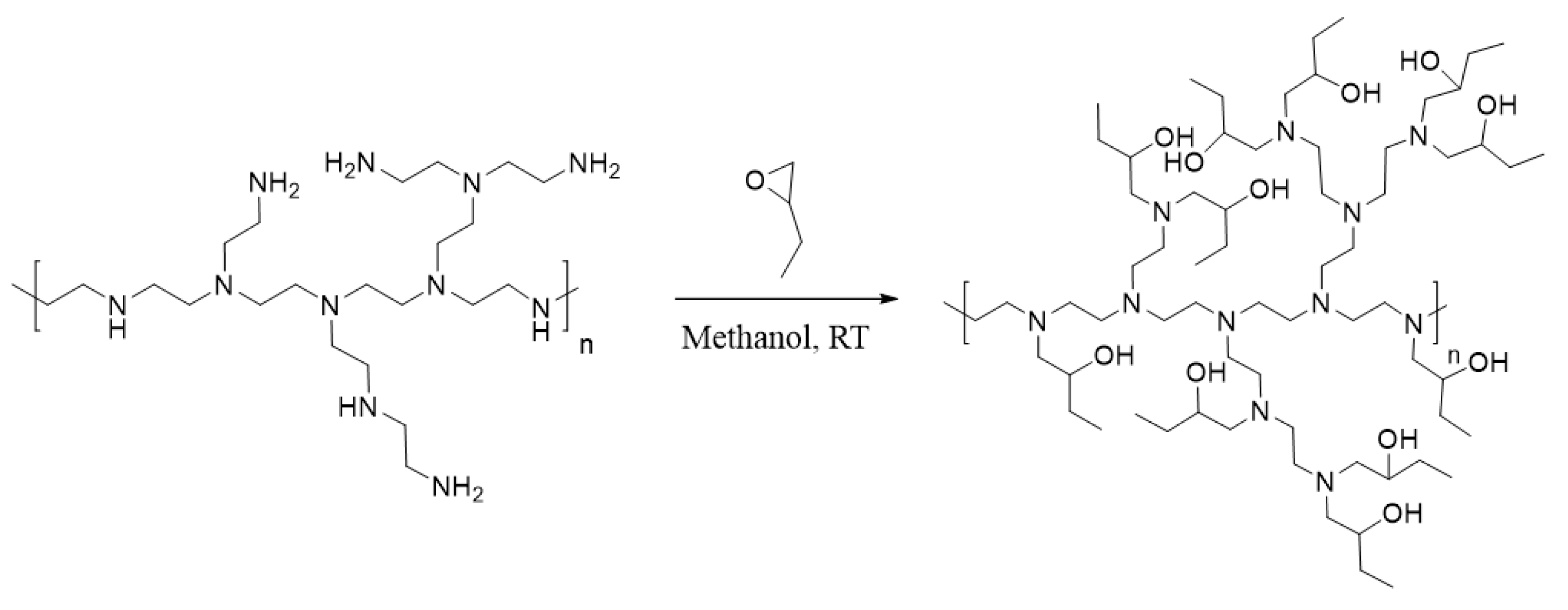
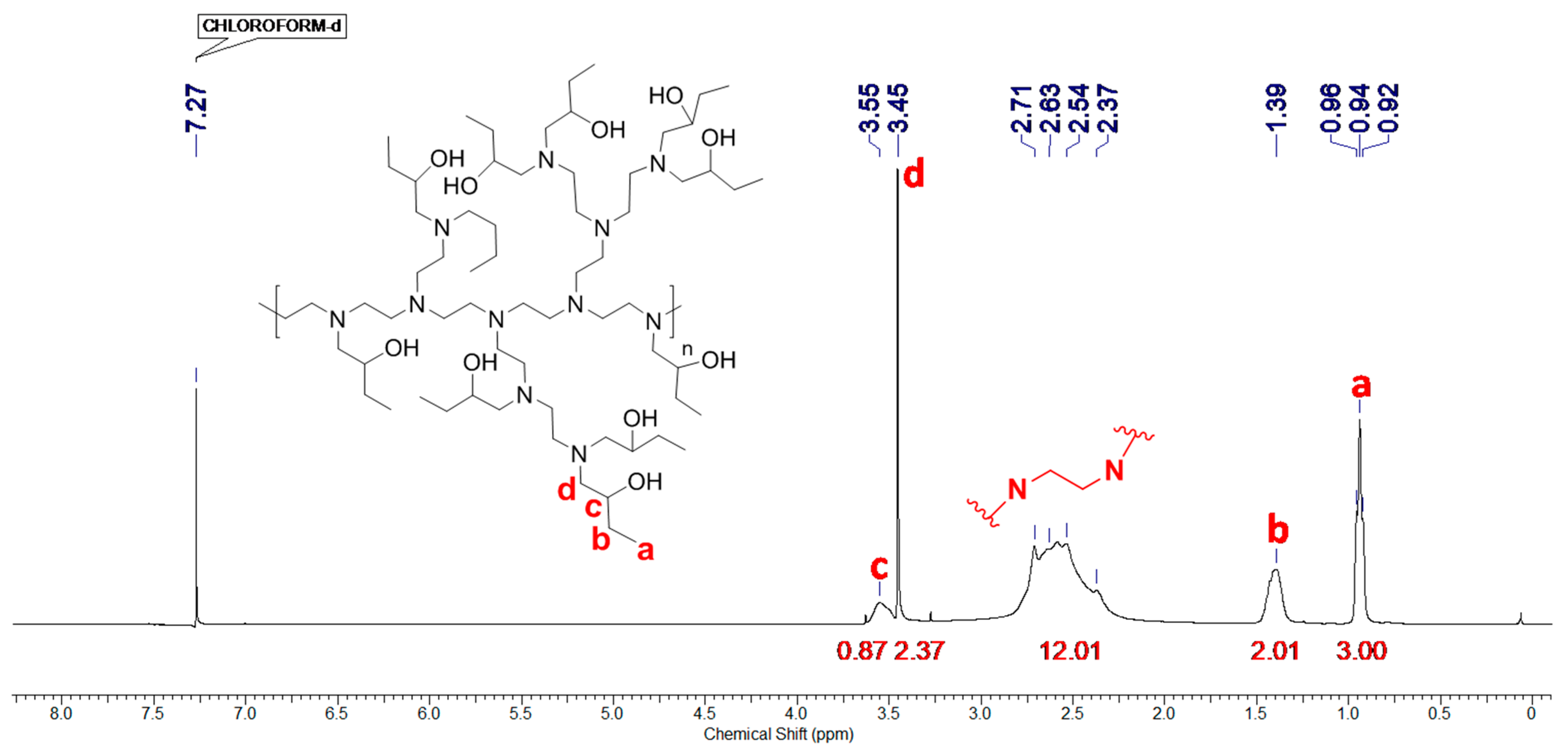



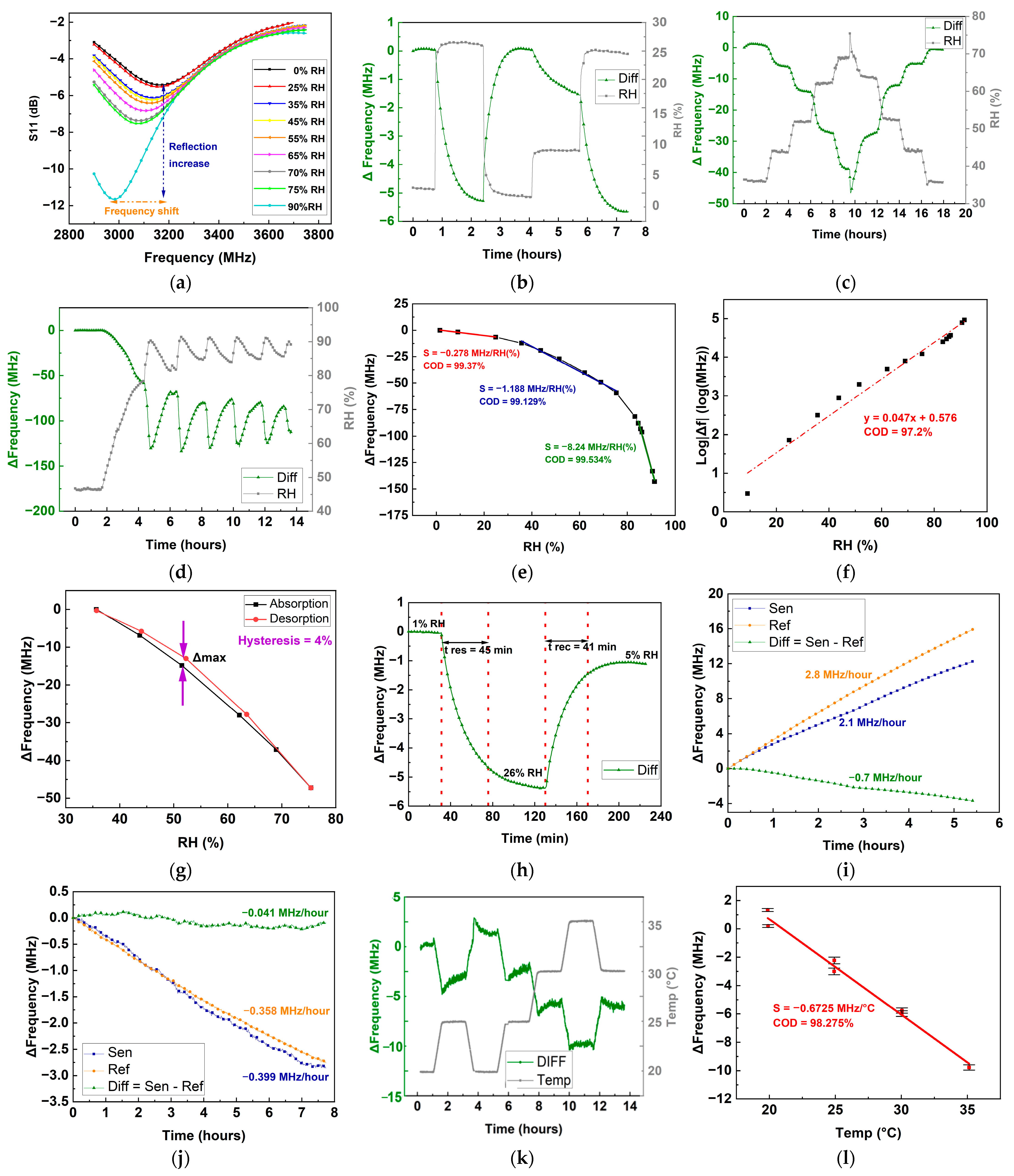
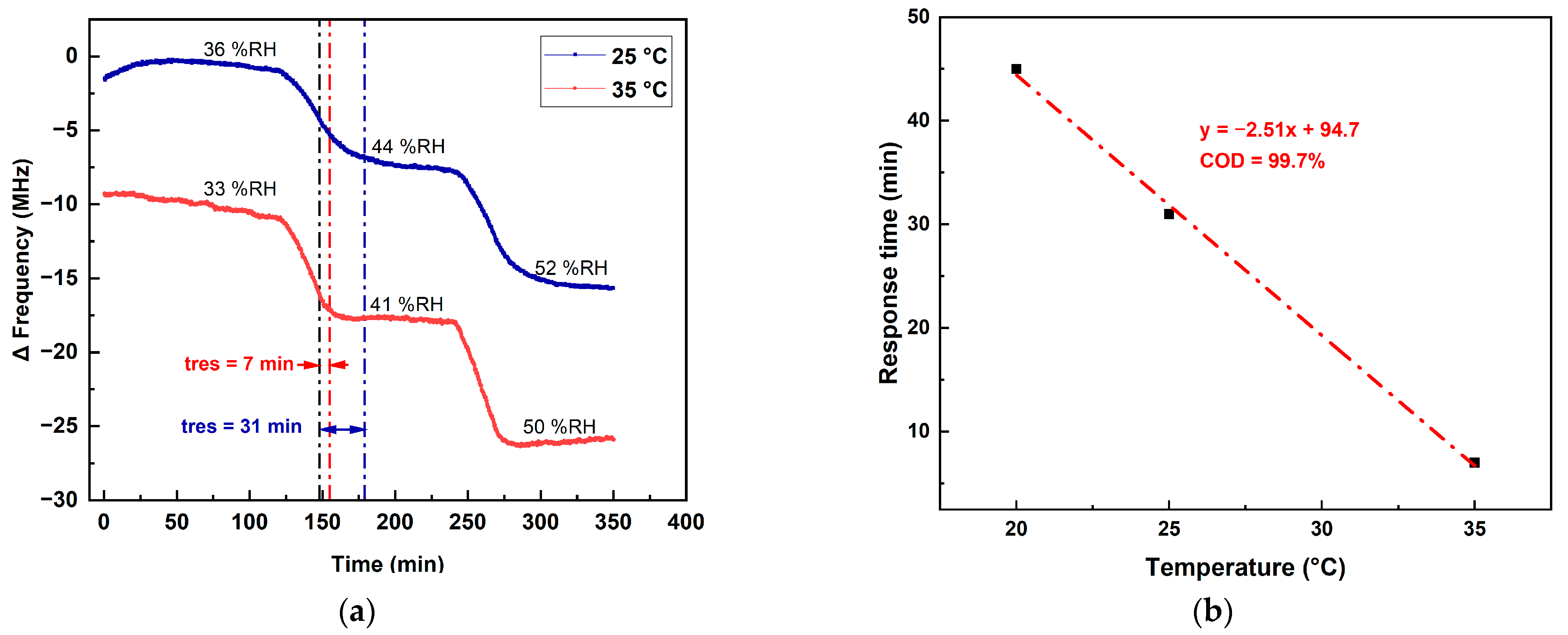

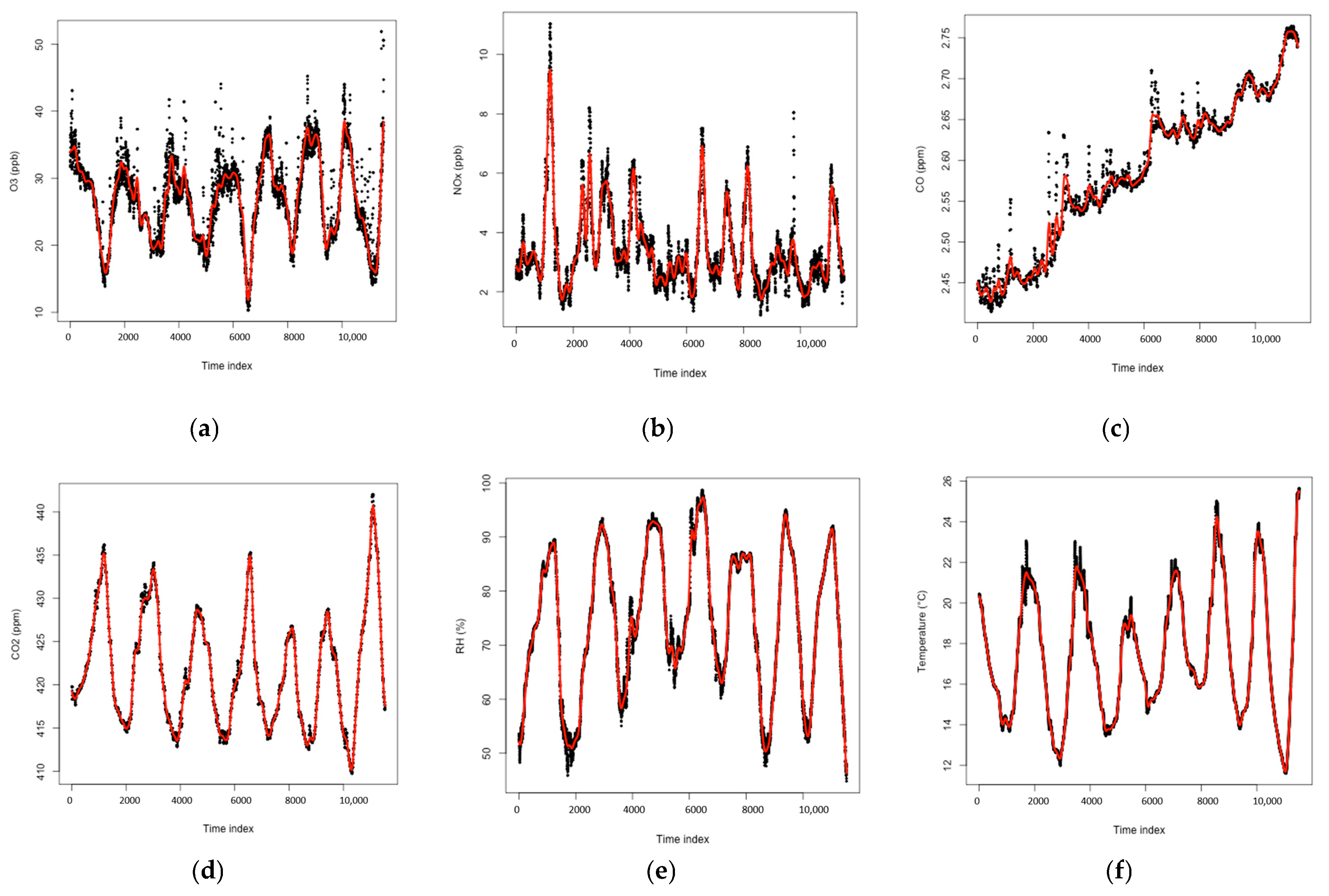
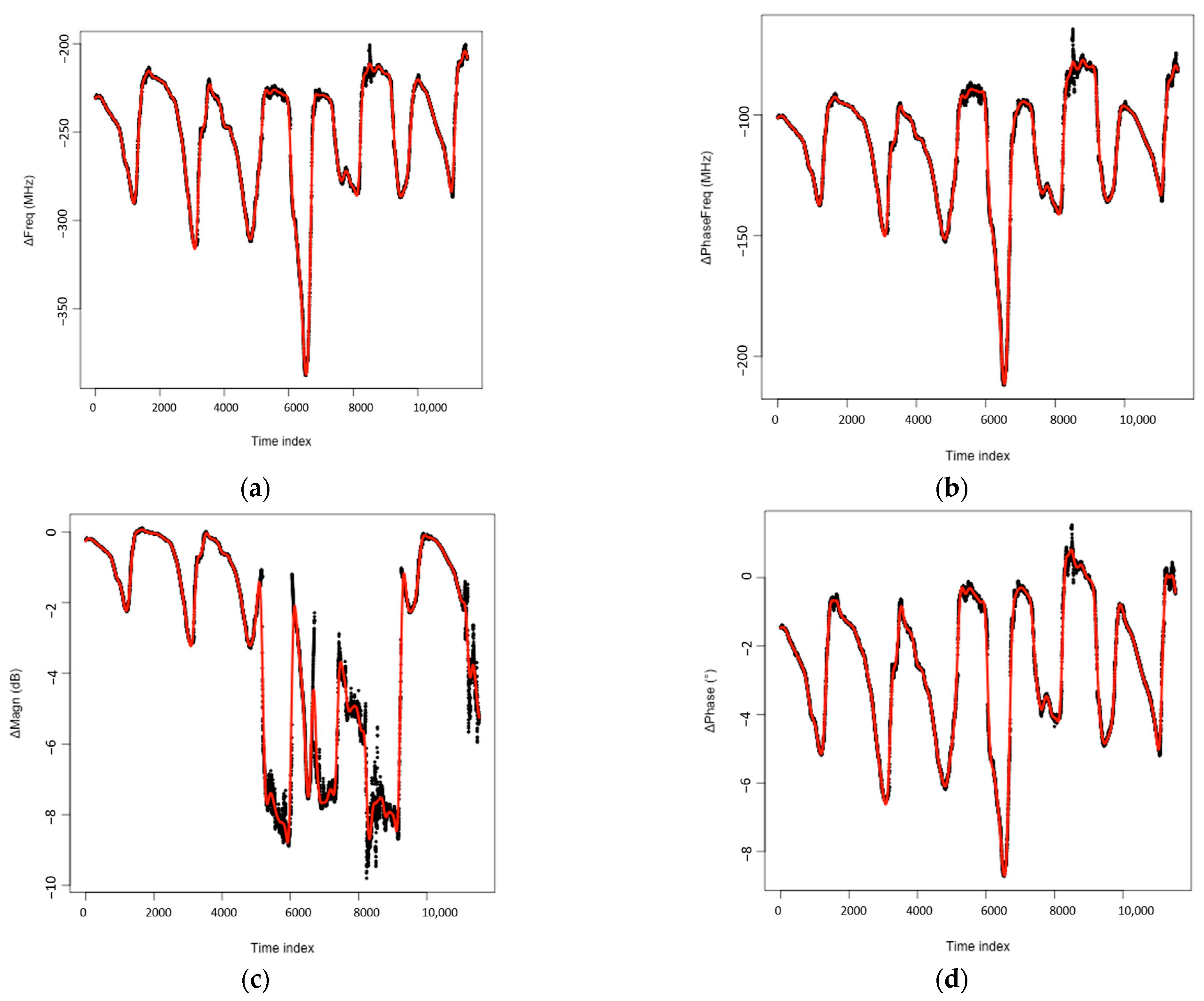
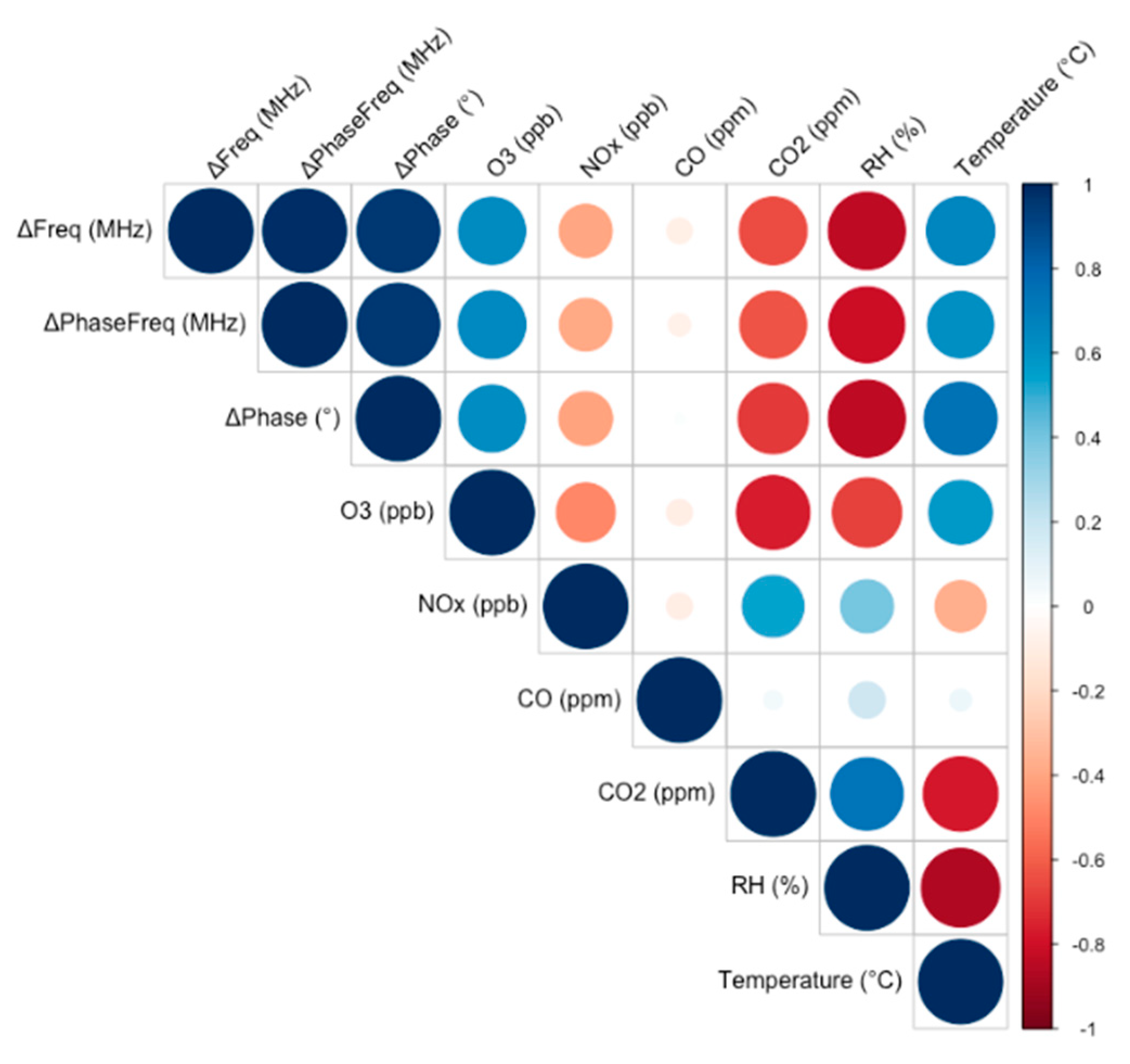
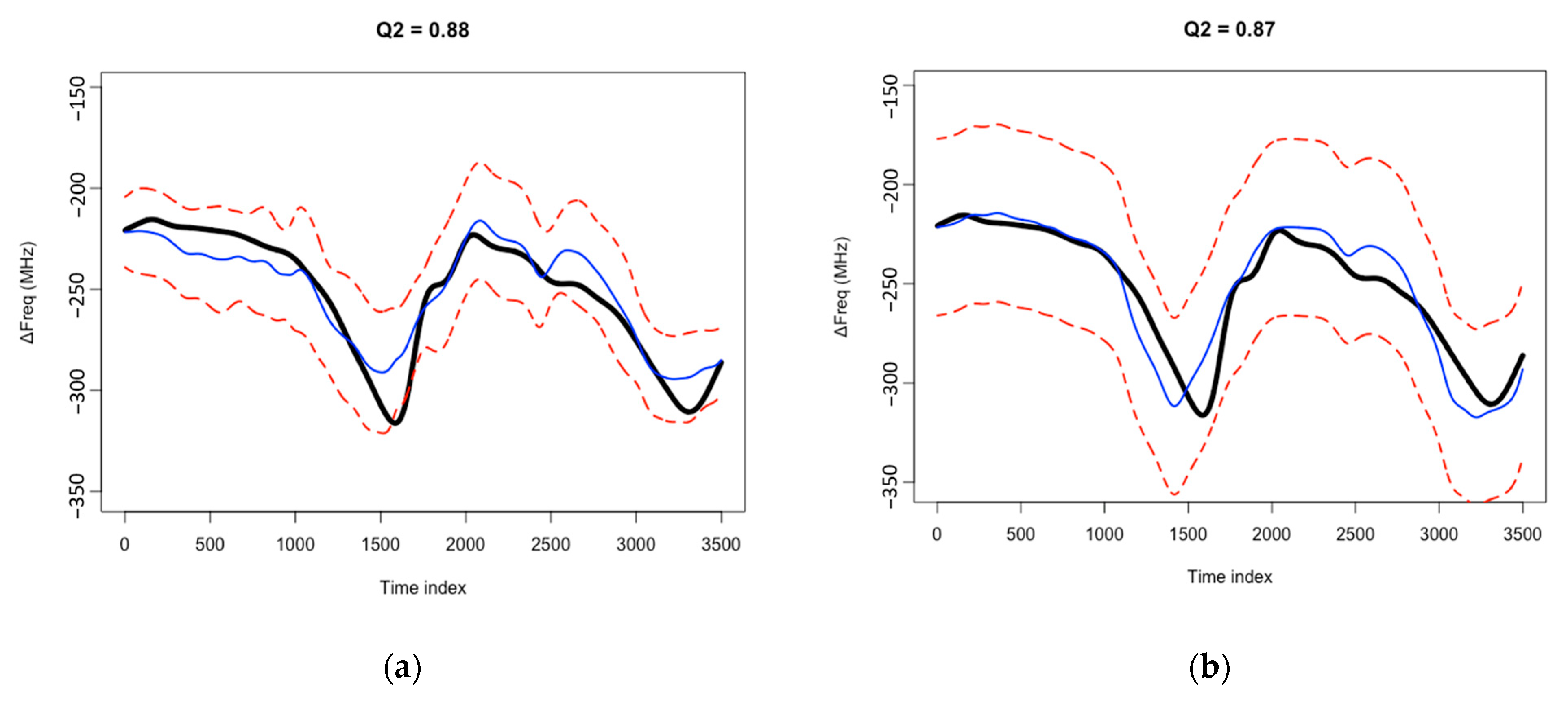

| Sensitive Material | Sensitivity (MHz/%RH) | Sensitivity (dB/%RH) | Range (%RH) | Hysteresis (%) | Fabrication | Frequency (GHz) | Ref |
|---|---|---|---|---|---|---|---|
| EB-PEI | 0.278 1.188 8.24 | 0.0033 0.030 0.171 | 0–30 30–70 >80 | <4 | Flexible PCB | 3.28 | This work |
| PEDOT: PSS | 0.252 0.992 | 0.0018 0.0058 | 20–50 50–80 | Not given | PCB | 2.4 | [36] |
| Polymeric film | 0.18 0.108 | 0.0049 0.0055 | 30–90 | 0.0013 | PCB | 3.3 5. | [37] |
| GO | 0.77 | 0.13 | 11.3–84.3 | 0.07 | PCB | 5.79 | [38] |
| CeO2 | 0.12 | 0.037 | 11–95 | Not given | PCB | 1.56 | [39] |
| MoO3 | 1.938 2.06 | 0.022 0.069 | 10–90 | 0.25 | PCB | 7.3 9.1 | [13] |
| CDs-Co3O4 | 3.40 | 0.16 | 5–99 | Not given | IPD (integrated passive device) | 1.57 | [12] |
| Unirradiated AgNPs | 3.17 12.61 | 0.250 0.121 | 15–51 51–87 | ~1.5 | Laser direct writing | ~8.3 | [40] |
| PVA | 6.75 | Not given | 50–90 | >25 | PCB | ~6.8 | [41] |
Disclaimer/Publisher’s Note: The statements, opinions and data contained in all publications are solely those of the individual author(s) and contributor(s) and not of MDPI and/or the editor(s). MDPI and/or the editor(s) disclaim responsibility for any injury to people or property resulting from any ideas, methods, instructions or products referred to in the content. |
© 2022 by the authors. Licensee MDPI, Basel, Switzerland. This article is an open access article distributed under the terms and conditions of the Creative Commons Attribution (CC BY) license (https://creativecommons.org/licenses/by/4.0/).
Share and Cite
Ngoune, B.B.; Hallil, H.; Lebental, B.; Perrin, G.; Shinde, S.; Cloutet, E.; George, J.; Bila, S.; Baillargeat, D.; Dejous, C. Selective Outdoor Humidity Monitoring Using Epoxybutane Polyethyleneimine in a Flexible Microwave Sensor. Chemosensors 2023, 11, 16. https://doi.org/10.3390/chemosensors11010016
Ngoune BB, Hallil H, Lebental B, Perrin G, Shinde S, Cloutet E, George J, Bila S, Baillargeat D, Dejous C. Selective Outdoor Humidity Monitoring Using Epoxybutane Polyethyleneimine in a Flexible Microwave Sensor. Chemosensors. 2023; 11(1):16. https://doi.org/10.3390/chemosensors11010016
Chicago/Turabian StyleNgoune, Bernard Bobby, Hamida Hallil, Bérengère Lebental, Guillaume Perrin, Shekhar Shinde, Eric Cloutet, Julien George, Stéphane Bila, Dominique Baillargeat, and Corinne Dejous. 2023. "Selective Outdoor Humidity Monitoring Using Epoxybutane Polyethyleneimine in a Flexible Microwave Sensor" Chemosensors 11, no. 1: 16. https://doi.org/10.3390/chemosensors11010016
APA StyleNgoune, B. B., Hallil, H., Lebental, B., Perrin, G., Shinde, S., Cloutet, E., George, J., Bila, S., Baillargeat, D., & Dejous, C. (2023). Selective Outdoor Humidity Monitoring Using Epoxybutane Polyethyleneimine in a Flexible Microwave Sensor. Chemosensors, 11(1), 16. https://doi.org/10.3390/chemosensors11010016






